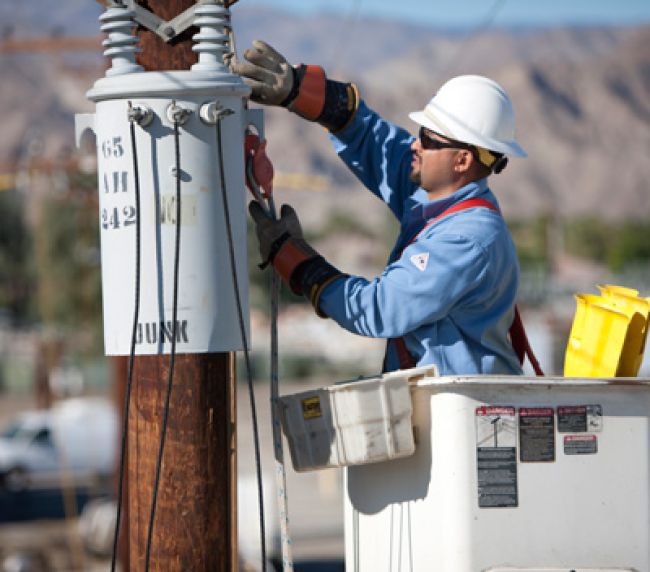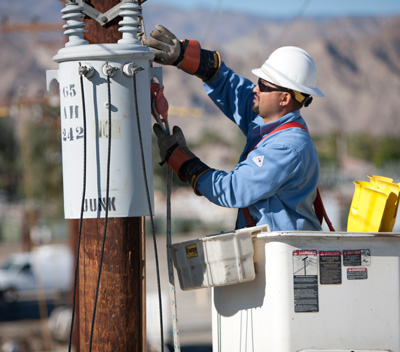
How to Navigate the FR Clothing Marketplace

When the original version of the OSHA 1910.269 standard was published, flame-resistant (FR) clothing wasn’t even mentioned. The dangers associated with electric arcs were known, but the standard only required that an employer not allow an employee to wear clothing that, when exposed to flames or electric arcs, could increase the extent of injury sustained by the employee. This was covered under 1910.269(l)(6)(iii). The rule eliminated the use of garments constructed with synthetics such as polyester, nylon, rayon and acetate, which could melt and drip, and led to the adoption of clothing made with 100 percent cotton. The problem was that non-FR cotton – once exposed to thermal energies beyond its ignition point – will ignite and continue to burn, thus adding to an injury.
Now that the much-anticipated revisions to the 1910.269 standard have been published, they have introduced a number of new challenges to the electric utility industry and those entrusted with their employees’ safety. Specifically, page 20317 of the final rule (see www.gpo.gov/fdsys/pkg/FR-2014-04-11/pdf/2013-29579.pdf) states that the “new provisions for protection from electric arcs include new requirements for the employer to: Assess the workplace to identify employees exposed to hazards from flames or from electric arcs, make reasonable estimates of the incident heat energy to which the employee would be exposed, ensure that the outer layer of clothing worn by employees is flame resistant under certain conditions, and generally ensure that employees exposed to hazards from electric arcs wear protective clothing and other protective equipment with an arc rating greater than or equal to the estimated heat energy.”
When a now-mandatory workplace assessment is performed, the incident energy found at a specific location is calculated in cal/cm2. This incident energy level determines what arc thermal protection value (ATPV) is needed to insulate and protect a worker against the hazard. To comply with the revised 1910.269 standard, the ATPV worn must be equal to or greater than the predicted incident energy.
Adhering to OSHA’s new requirements is challenging and may seem somewhat overwhelming at times, but before we go any further, let’s pause for a moment to remind ourselves why building FR clothing programs is in the best interest of our employees. An arc flash is a sudden flash or release of electric current that flows through electrically charged ionized air. As a result of this short circuit, the surrounding area is filled – within fractions of a second – with an explosive blast, high-pressure thermal waves that can reach up to 35,000 degrees Fahrenheit, ear-shattering acoustical shock waves, toxic metal vapor and dangerous flying debris and shrapnel. Fatal burns can afflict those within 5 feet of an arc flash, with severe burns occurring within 10 feet. The pressure wave created by an arc flash explosion can damage eyesight, hearing and brain function. By implementing an FR clothing program at your organization and ensuring your employees follow its requirements, you are helping to protect them from potentially deadly hazards. Even if OSHA’s new law weren’t in effect, it is a safety best practice to demand that workers wear FR clothing when necessary.
Understanding the FR Supplier Landscape
So now that you must outfit your employees in the proper FR clothing when they are exposed to arc flash hazards, how do you accomplish that? It starts with educating yourself about the key players in the supplier marketplace.
In today’s market, premium suppliers are utilizing fabrics and technologies that have been well-researched, well-tested and market-proven. These fabrics have been extensively tested in laboratories in realistic, simulated work setups and on the job to confirm they are comfortable and perform as advertised. With multiple manufacturers using numerous fabrics constructed in a variety of manners and offered through multiple channels, following is a simplified view of the manufacturing and selling landscape for FR clothing.
Fabric Manufacturers
These companies are responsible for spinning, weaving and/or finishing FR fabrics and testing them to ASTM, OSHA, NFPA and/or independent standards.
Garment Manufacturers
These companies cut and sew a wide variety of FR fabrics. They may sell direct or through distributors.
Suppliers
They may manufacture their own garments or distribute garments from other FR manufacturers. Some suppliers sell direct only, through distributors only or a combination of both.
Industrial Laundries
Most industrial laundries have access to multiple brands of FR apparel, and they rent these brands to a variety of industries. Some national laundries manufacture a line of FR garments with their own brand name.
Distributors
There are hundreds of distributors that have access to multiple FR brands.
Key Decisions for Beginning a Program
Once you have a solid understanding of the FR supplier landscape and have determined the incident energy exposures in the workplace in accordance with the OSHA standards, you can move on to the clothing procurement stage. There are three basic decisions to be made during the procurement process:
1. What fabric best meets the level of protection you need?
2. What garment style is going to be the most comfortable for your employees to wear?
3. Logistically, what supply channel best suits your company? Industrial laundry? Safety distributor? Another option?
Choosing a Supplier
The FR clothing industry is a crowded one, and with all there is for utilities to understand and all the questions there are to be answered, partnering with a full-service supplier can provide an employer with valuable services in addition to clothing. Look for suppliers that can deliver detailed performance data, including layered materials tests. A valued supplier’s services also include broad technical expertise regarding fabrics and rules of use as well as detailed records of materials proof testing and chain of custody for manufactured fabrics.
Partnering with a supplier who controls their supply chain, has evaluated all the fabrics, has the resources to guarantee performance, is innovative in garment design and has readily available technical training and support will make choosing and implementing an FR clothing program significantly less daunting.
Comfort Considerations
FR clothing must be worn by employees for their safety. But it is also vital that workers are comfortable in the selected clothing as discomfort leads to an increased risk of noncompliance and, in turn, injuries. FR clothing should fit in a way that allows for unrestricted movement. It should not be too tight or too loose so as to interfere with the tasks to be performed. Because different workers may find different materials more comfortable than others, it is beneficial to let workers try out FR clothing in advance. In addition, PPE for high incident energy may require thicker and heavier clothing, headgear and gloves. Therefore, it is recommended that the worker practice wearing the PPE before working on live exposed equipment. This also ensures that the PPE does not interfere with the task.
Layering is a common practice because multiple layers can and do provide additional protection. Multilayer FR clothing can also be more comfortable than a single layer of thick, heavy clothing. Layering is becoming more important as utilities are tasked with matching the incident energy determined by their hazard assessments to the ATPVs of their clothing systems. Keep in mind that it is critical to test layered garments together in the order they are to be worn; without that information you can only consider the outermost layer’s ATPV.
Conclusion
The FR clothing landscape is complex, with multiple solutions in every category from which to choose, whether it’s fabrics, manufacturers, distributors or industrial laundries. By partnering with a supplier that’s right for your organization, you can be confident that you and your employees are protected against the worst-case scenario.
About the Author: Derek Sang is the technical training manager for Bulwark Protective Apparel. He has been involved in the flame-resistant clothing industry for more than 20 years. During that time he has developed and conducted over 250 educational and informational seminars on the hazards of arc flash and flash fire for a variety of organizations including the American Society of Safety Engineers, National Safety Council and National Electrical Contractors Association. Sang can be reached at derek_sang@vfc.com.

